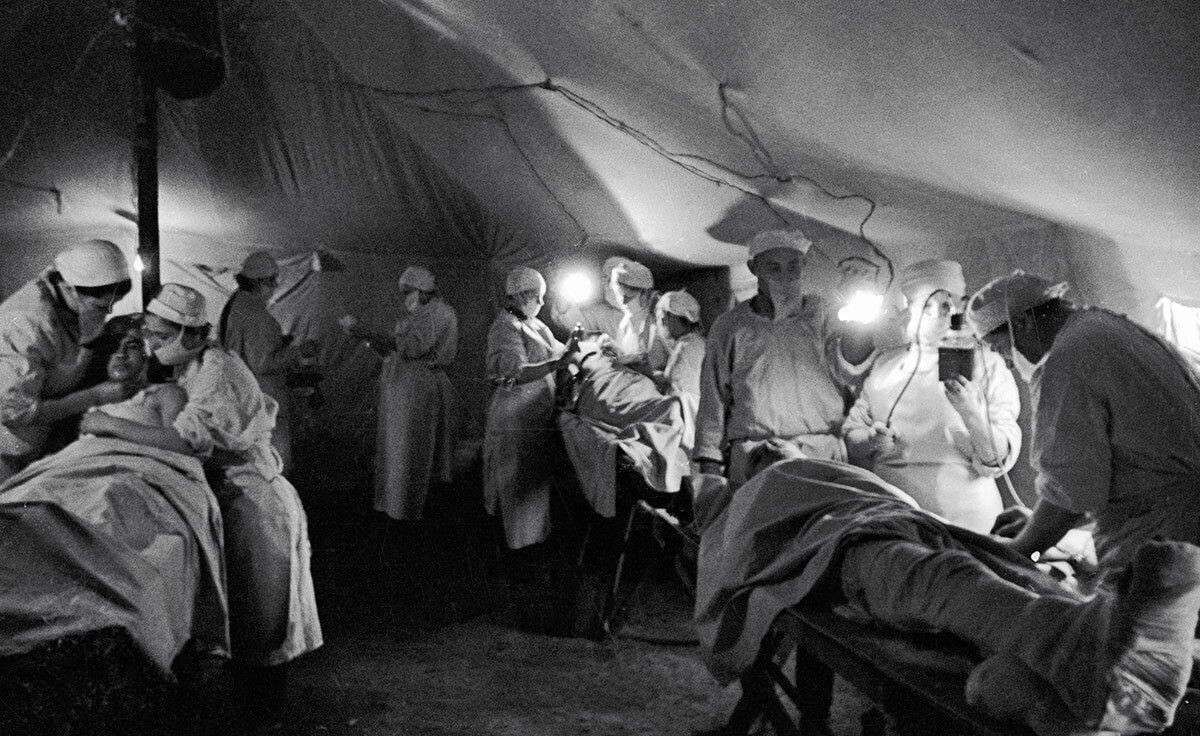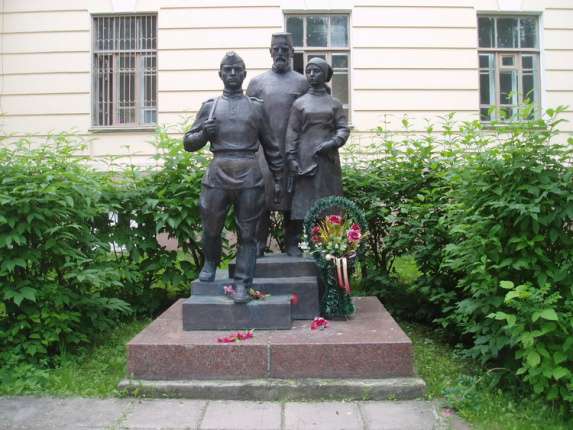During the war years, three large scientific and medical centers (Tomsk, Novosibirsk, Omsk) were formed in Western Siberia, which were characterized by a high concentration of scientific forces and included well-known theorists and practitioners of medicine.
The Tomsk Center included the Gorky All-Union Institute of Experimental Medicine (VIEM) evacuated here, the Central Institute of Psychiatry of the People’s Commissariat of Health of the RSFSR, the Scientific Research Institute of the Sanitary Inspection of the Red Army of the USSR, as well as the Tomsk Institute of Epidemiology and Microbiology (TIEM) and Tomsk Medical Institute.
During the war, rear Tomsk was not only a place where enterprises and various strategically important organizations were evacuated, but also trains with wounded soldiers were delivered literally from the first days of the war. Evacuation hospitals in Tomsk were formed already in July 1941.
A total of 26 hospitals operated in Tomsk from 1941 to 1945. All of them were placed in the best rooms of the city, academic buildings and dormitories of institutes, the House of Science, hotels, schools. The city provided hospitals with the necessary equipment and medicines, fuel and food, and staffed them with medical and household staff. The most important task was solved by medical workers, returning the wounded and sick to work and fighting to prevent epidemics.


The achievements of medical scientists have largely contributed to solving the most important medical problems. First of all, this is the problem of treating complications of gunshot wounds.
For this purpose Professor D.I. Goldberg was the first to propose an embryonic ointment, Professor V.G. Eliseev – vitamin ointment, associate professor S.I. Povolotsky – fir ointment. Professor S.P. Karpov, associate professor S.P. Khodkevich and others developed a method of irrigation of wounds with 10-15% honey solution, doctor E.I. Badigina developed a method of irradiation of wounds with radioactive mineral “Carnelian”, prof. B.P. Tokin proposed the use of phytoncides.
The solution of the problems of acute shortage of dressings (cotton wool, gauze) was facilitated by the proposals of surgeons Professor A.G.Savinykh and associate professor S.P. Khodkevich to use sphagnum moss as a substitute for cotton wool and Professor M.S.Rabinovich to use algae for this purpose. In addition, according to the proposals of scientists, instead of gauze, special paper made from sawdust was used; regenerated gauze, a plaster bandage with a pus absorber, proposed by Associate Professor V.P. Zakharzhevsky, were widely used.
The importance of scientific research by microbiologists, epidemiologists, and infectious diseases specialists of the Medical Institute has gone far beyond the limits of Tomsk and Siberia. Methods of production of various therapeutic and prophylactic serums and bacteriophage have been developed.
Since 1944, the Tomsk Medical Institute has organized the mass production of native penicillin, gramicidin, which were used in hospitals and clinics in Tomsk, Omsk and other Siberian cities in the treatment of many diseases and complications of gunshot wounds.

The memorial monument to the staff of the medical Institute who worked in hospitals and clinics during the war and went to the front was inaugurated on the eve of the celebration of the 45th anniversary of the Victory – on May 7, 1990 near the main building of SibSMU in Tomsk. The authors of the sculptural composition were a group of Moscow sculptors and Tomsk architect V.F. Kosonogov.
Sources of information:
Zelenin S.F. The activity of medical scientists in Western Siberia during the Great Patriotic War (1941-1945)/ S.F. Zelenin – Tomsk: Siberian Publishing House. 2002. – 168 p.
Doctors during the Great Patriotic War: a collection of biographical information / Siberian Medical University (Tomsk). – Tomsk: 2005. – 64 p.
*The material was prepared by Isaenkova O.A.






![Педиатрия по Нельсону / под ред. Р. М. Клигмана, Дж. У. Сент-Джима III, Н. Дж. Блума [и др.] Том 4 Главы 558-748. - 2023 Педиатрия по Нельсону / под ред. Р. М. Клигмана, Дж. У. Сент-Джима III, Н. Дж. Блума [и др.] Том 4 Главы 558-748. - 2023](https://lib.ssmu.ru/ebs_news/0.jpg)
![Педиатрия по Нельсону / под ред. Р. М. Клигмана, Дж. У. Сент-Джима III, Н. Дж. Блума [и др.] Том 3 Главы 314-557. - 2023 Педиатрия по Нельсону / под ред. Р. М. Клигмана, Дж. У. Сент-Джима III, Н. Дж. Блума [и др.] Том 3 Главы 314-557. - 2023](https://lib.ssmu.ru/ebs_news/1.jpg)
![Педиатрия по Нельсону / под ред. Р. М. Клигмана, Дж. У. Сент-Джима III, Н. Дж. Блума [и др.] Том 2 Главы 117-313. - 2023 Педиатрия по Нельсону / под ред. Р. М. Клигмана, Дж. У. Сент-Джима III, Н. Дж. Блума [и др.] Том 2 Главы 117-313. - 2023](https://lib.ssmu.ru/ebs_news/2.jpg)
![Педиатрия по Нельсону / под ред. Р. М. Клигмана, Дж. У. Сент-Джима III, Н. Дж. Блума [и др.] Том 1 Главы 1-116. - 2023 Педиатрия по Нельсону / под ред. Р. М. Клигмана, Дж. У. Сент-Джима III, Н. Дж. Блума [и др.] Том 1 Главы 1-116. - 2023](https://lib.ssmu.ru/ebs_news/3.jpg)









